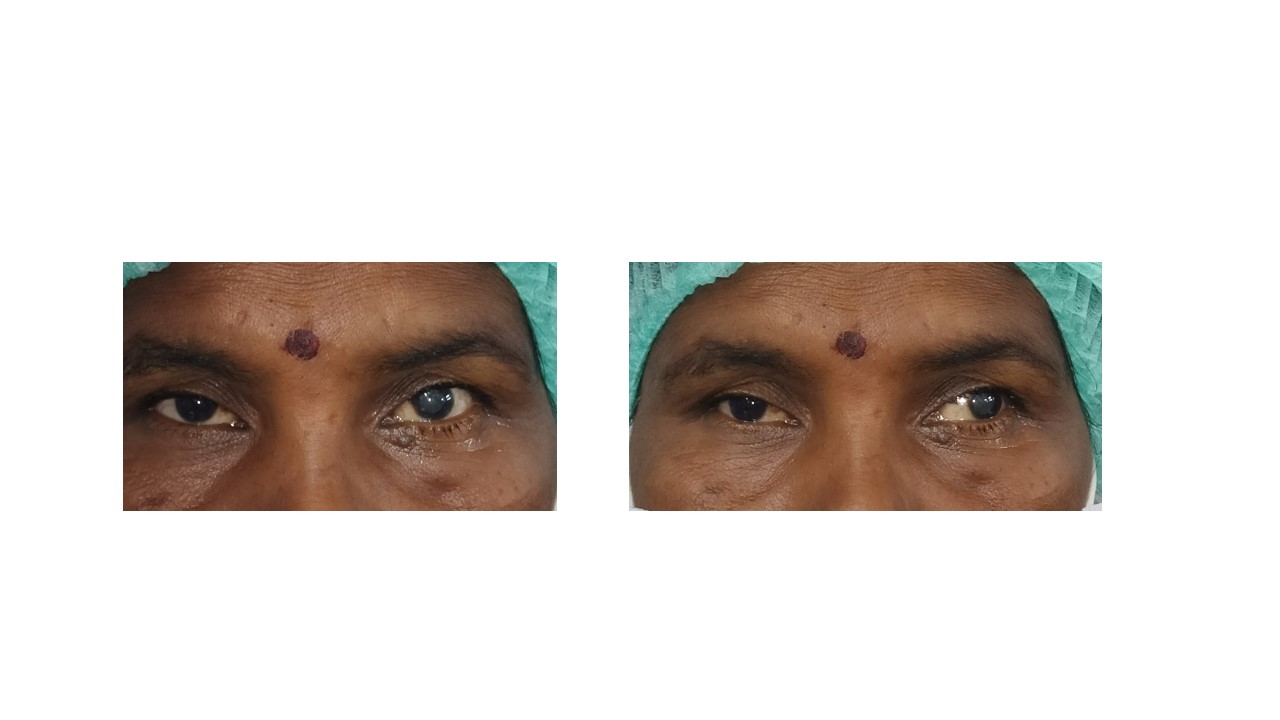[1]
Tang W,He B,Luo J,Deng Z,Wang X,Duan X, Effect of the Control Ability on Stereopsis Recovery of Intermittent Exotropia in Children. Journal of pediatric ophthalmology and strabismus. 2021 Aug 1;
[PubMed PMID: 34435904]
[2]
Lee JY,Park KA,Oh SY, Lateral rectus muscle recession for intermittent exotropia with anomalous head position in type 1 Duane's retraction syndrome. Graefe's archive for clinical and experimental ophthalmology = Albrecht von Graefes Archiv fur klinische und experimentelle Ophthalmologie. 2018 Dec;
[PubMed PMID: 30062561]
[3]
Wu Y,Peng T,Zhou J,Xu M,Gao Y,Zhou J,Hou F,Yu X, A Survey of Clinical Opinions and Preferences on the Non-surgical Management of Intermittent Exotropia in China. Journal of binocular vision and ocular motility. 2021 Aug 27;
[PubMed PMID: 34449280]
Level 3 (low-level) evidence
[4]
Bui Quoc E, Milleret C. Origins of strabismus and loss of binocular vision. Frontiers in integrative neuroscience. 2014:8():71. doi: 10.3389/fnint.2014.00071. Epub 2014 Sep 25
[PubMed PMID: 25309358]
[5]
Cooper J, Intermittent exotropia of the divergence excess type. Journal of the American Optometric Association. 1977 Oct;
[PubMed PMID: 908827]
[6]
Kushner BJ,Morton GV, Distance/near differences in intermittent exotropia. Archives of ophthalmology (Chicago, Ill. : 1960). 1998 Apr;
[PubMed PMID: 9565045]
[7]
Kekunnaya R,Chandrasekharan A,Sachdeva V, Management of Strabismus in Myopes. Middle East African journal of ophthalmology. 2015 Jul-Sep;
[PubMed PMID: 26180467]
[8]
von Noorden GK,Avilla CW, Accommodative convergence in hypermetropia. American journal of ophthalmology. 1990 Sep 15;
[PubMed PMID: 2396654]
[9]
JAMPOLSKY A,FLOM BC,WEYMOUTH FW,MOSES LE, Unequal corrected visual acuity as related to anisometropia. A.M.A. archives of ophthalmology. 1955 Dec;
[PubMed PMID: 13268145]
[11]
JAMPOLSKY A, Differential diagnostic characteristics of intermittent exotropia and true exophoria. The American orthoptic journal. 1954 Jun;
[PubMed PMID: 13180847]
[13]
Pan CW,Zhu H,Yu JJ,Ding H,Bai J,Chen J,Yu RB,Liu H, Epidemiology of Intermittent Exotropia in Preschool Children in China. Optometry and vision science : official publication of the American Academy of Optometry. 2016 Jan;
[PubMed PMID: 26583796]
[14]
Govindan M,Mohney BG,Diehl NN,Burke JP, Incidence and types of childhood exotropia: a population-based study. Ophthalmology. 2005 Jan;
[PubMed PMID: 15629828]
[15]
Kelkar JA,Gopal S,Shah RB,Kelkar AS, Intermittent exotropia: Surgical treatment strategies. Indian journal of ophthalmology. 2015 Jul;
[PubMed PMID: 26458472]
[16]
BURIAN HM,SPIVEY BE, THE SURGICAL MANAGEMENT OF EXODEVIATIONS. American journal of ophthalmology. 1965 Apr;
[PubMed PMID: 14270998]
[17]
Wang X,Wang F,Xi S,Jiang C,Liu Y,Wen W,Zhao C, Short-Term Near Stereoacuity Improvements Following Favorable Surgical Alignment in Exotropic and Esotropic Patients. Seminars in ophthalmology. 2021 Jul 5;
[PubMed PMID: 34223803]
[18]
Haggerty H,Richardson S,Hrisos S,Strong NP,Clarke MP, The Newcastle Control Score: a new method of grading the severity of intermittent distance exotropia. The British journal of ophthalmology. 2004 Feb;
[PubMed PMID: 14736781]
[19]
Buck D,Clarke MP,Haggerty H,Hrisos S,Powell C,Sloper J,Strong NP, Grading the severity of intermittent distance exotropia: the revised Newcastle Control Score. The British journal of ophthalmology. 2008 Apr;
[PubMed PMID: 18369078]
[20]
Stathacopoulos RA,Rosenbaum AL,Zanoni D,Stager DR,McCall LC,Ziffer AJ,Everett M, Distance stereoacuity. Assessing control in intermittent exotropia. Ophthalmology. 1993 Apr;
[PubMed PMID: 8479706]
[21]
Sharma P,Saxena R,Narvekar M,Gadia R,Menon V, Evaluation of distance and near stereoacuity and fusional vergence in intermittent exotropia. Indian journal of ophthalmology. 2008 Mar-Apr;
[PubMed PMID: 18292622]
[22]
Zanoni D,Rosenbaum AL, A new method for evaluating distance stereo acuity. Journal of pediatric ophthalmology and strabismus. 1991 Sep-Oct;
[PubMed PMID: 1955959]
[24]
Barrett BT, A critical evaluation of the evidence supporting the practice of behavioural vision therapy. Ophthalmic
[PubMed PMID: 19154276]
[25]
Jackson JH,Arnoldi K, The Gradient AC/A Ratio: What's Really Normal? The American orthoptic journal. 2004;
[PubMed PMID: 21149096]
[26]
Kushner BJ, The distance angle to target in surgery for intermittent exotropia. Archives of ophthalmology (Chicago, Ill. : 1960). 1998 Feb;
[PubMed PMID: 9488270]
[27]
Pediatric Eye Disease Investigator Group.,Writing Committee.,Mohney BG,Cotter SA,Chandler DL,Holmes JM,Wallace DK,Yamada T,Petersen DB,Kraker RT,Morse CL,Melia BM,Wu R, Three-Year Observation of Children 3 to 10 Years of Age with Untreated Intermittent Exotropia. Ophthalmology. 2019 Sep;
[PubMed PMID: 30690128]
[28]
Romanchuk KG,Dotchin SA,Zurevinsky J, The natural history of surgically untreated intermittent exotropia-looking into the distant future. Journal of AAPOS : the official publication of the American Association for Pediatric Ophthalmology and Strabismus. 2006 Jun;
[PubMed PMID: 16814175]
[30]
Iacobucci IL,Archer SM,Giles CL, Children with exotropia responsive to spectacle correction of hyperopia. American journal of ophthalmology. 1993 Jul 15;
[PubMed PMID: 8328547]
[31]
Caltrider N,Jampolsky A, Overcorrecting minus lens therapy for treatment of intermittent exotropia. Ophthalmology. 1983 Oct;
[PubMed PMID: 6657190]
[32]
Watts P,Tippings E,Al-Madfai H, Intermittent exotropia, overcorrecting minus lenses, and the Newcastle scoring system. Journal of AAPOS : the official publication of the American Association for Pediatric Ophthalmology and Strabismus. 2005 Oct;
[PubMed PMID: 16213396]
[33]
Freeman RS,Isenberg SJ, The use of part-time occlusion for early onset unilateral exotropia. Journal of pediatric ophthalmology and strabismus. 1989 Mar-Apr;
[PubMed PMID: 2709283]
[34]
Pediatric Eye Disease Investigator Group.,Cotter SA,Mohney BG,Chandler DL,Holmes JM,Repka MX,Melia M,Wallace DK,Beck RW,Birch EE,Kraker RT,Tamkins SM,Miller AM,Sala NA,Glaser SR, A randomized trial comparing part-time patching with observation for children 3 to 10 years of age with intermittent exotropia. Ophthalmology. 2014 Dec;
[PubMed PMID: 25234012]
Level 1 (high-level) evidence
[35]
Pratt-Johnson JA,Tillson G, Prismotherapy in intermittent exotropia. A preliminary report. Canadian journal of ophthalmology. Journal canadien d'ophtalmologie. 1979 Oct;
[PubMed PMID: 550916]
[36]
Moore S, The prognostic value of lateral gaze measurements in intermittent exotropia. The American orthoptic journal. 1969;
[PubMed PMID: 5792797]
[37]
Spencer RF,Tucker MG,Choi RY,McNeer KW, Botulinum toxin management of childhood intermittent exotropia. Ophthalmology. 1997 Nov;
[PubMed PMID: 9373104]
[38]
Pineles SL,Deitz LW,Velez FG, Postoperative outcomes of patients initially overcorrected for intermittent exotropia. Journal of AAPOS : the official publication of the American Association for Pediatric Ophthalmology and Strabismus. 2011 Dec;
[PubMed PMID: 22153394]
[39]
Bae GH,Bae SH,Choi DG, Surgical outcomes of intermittent exotropia according to exotropia type based on distance/near differences. PloS one. 2019;
[PubMed PMID: 30908548]
[40]
Lee CM,Sun MH,Kao LY,Lin KK,Yang ML, Factors affecting surgical outcome of intermittent exotropia. Taiwan journal of ophthalmology. 2018 Jan-Mar;
[PubMed PMID: 29675346]
[41]
Olitsky SE,Coats DK, Complications of Strabismus Surgery. Middle East African journal of ophthalmology. 2015 Jul-Sep;
[PubMed PMID: 26180463]

